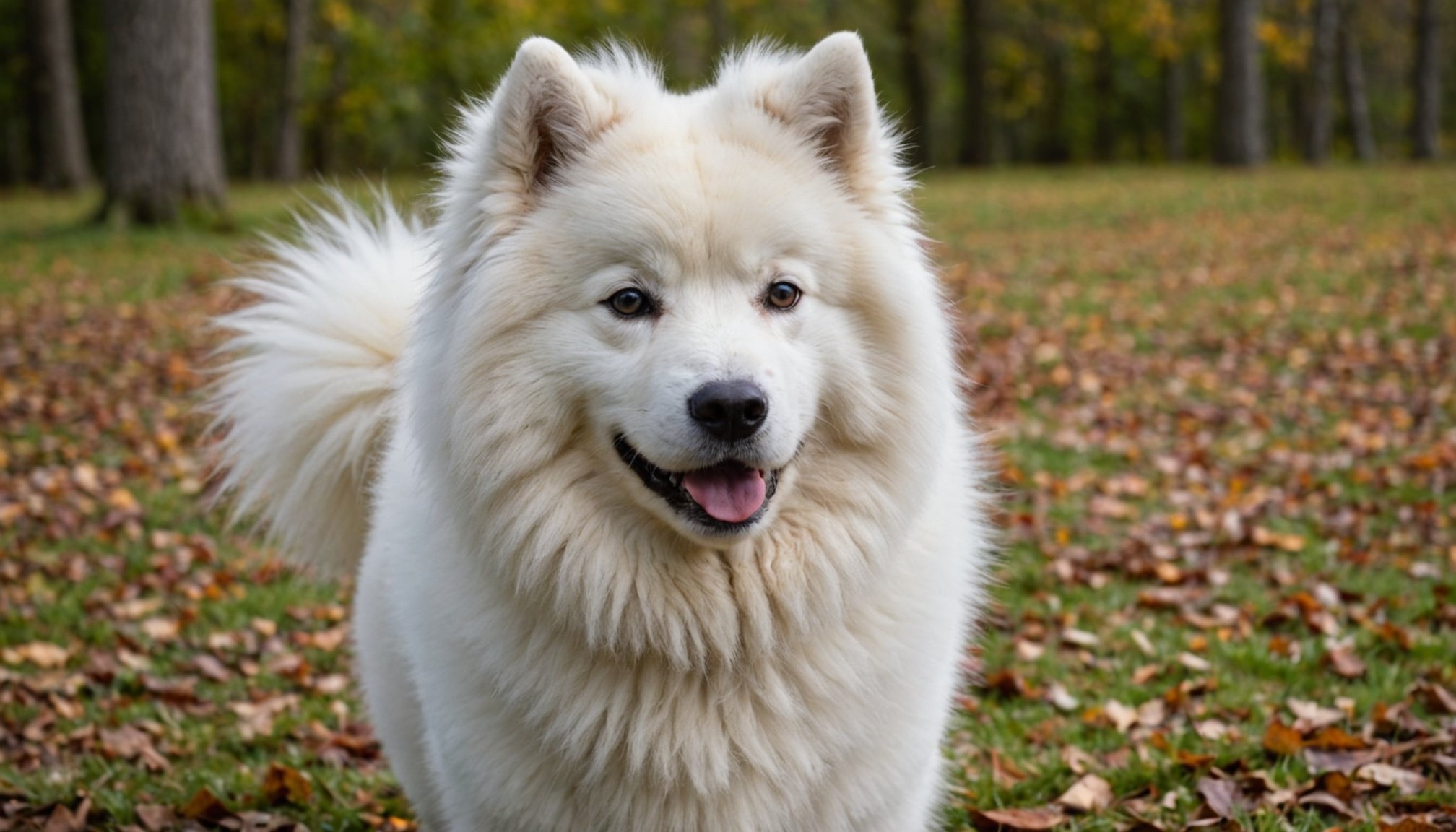Understanding Shedding in Double-Coated Breeds
Double-coated breeds, such as Samoyeds, have a unique way of shedding that differs significantly from single-coated breeds. These dogs have a dense undercoat beneath a top layer of longer guard hairs, which helps them stay insulated. The shedding explanation involves understanding how these two layers work together.
Seasonal Shedding Phases
One of the most notable aspects of shedding in double-coated breeds is their seasonal shedding patterns. These dogs typically blow their coat twice a year, in spring and fall. During these phases, they shed the undercoat to adjust their insulation for the changing temperatures. This natural process ensures their comfort and can result in quite a bit of loose hair around the home.
Topic to read : Essential Nutritional Requirements for a Pregnant Dachshund: Ensuring Healthy Puppies Through Proper Diet
The Biology Behind a Samoyed’s Coat
The biology of a Samoyed’s coat is particularly interesting. Designed to endure frosty climates, their double coat consists of a soft, thick undercoat that traps body heat and long, white guard hairs that repel moisture and dirt. Understanding the biology behind this dual-layer coat is crucial in managing shedding and maintaining the coat’s health. Regular grooming can help manage the amount of shedding by encouraging the natural cycle and reducing loose hair around your living space.
Essential Grooming Techniques
Grooming your Samoyed isn’t merely about aesthetics; it’s about maintaining their health and comfort. One of the most vital grooming tips is regular brushing. For double-coated breeds like Samoyeds, effective brushing is crucial. It helps in preventing mats and tangles in their fur, which can cause skin problems if neglected.
Also to discover : Mastering Water Confidence: A Guide to Training Your Dalmatian for Fun Swimming Adventures!
Effective brushing starts with choosing the right tools. You’ll need a pin brush and slicker brush, which are essential for fur management. A pin brush works well for detangling the long outer coat, while a slicker brush helps in removing loose hair and debris from the dense undercoat.
How often should you groom your Samoyed? Ideally, you should aim for at least two to three grooming sessions per week. This frequency not only helps in managing shedding, but also keeps your Samoyed comfortable and reduces the mess in your home. During heavy shedding seasons, such as spring and fall, daily grooming can be more effective.
Be mindful of sensitive areas such as behind the ears and under the legs. Regular grooming not only keeps your Samoyed looking great but also strengthens the bond between you and your pet.
Establishing a Shedding Schedule
When setting up a shedding schedule for your pet, understanding their breed’s coat type is crucial, particularly for double-coated breeds. These breeds tend to have distinct shedding peaks that align with seasonal changes. To manage this effectively, start by creating a seasonal grooming schedule. This will help you address these natural patterns and keep your home fur-free.
First, identify the primary shedding times, which typically occur twice a year during spring and autumn. This is when the fur transitions to prepare for the varying temperatures. During these periods, increase grooming frequency to help your pet through the fur loss process. Brushing more frequently during these times can also prevent matting and reduce allergens in the home.
Moreover, adjust your routine care based on monitoring fur loss. If you notice excessive shedding outside the usual periods, it might indicate stress or health issues, requiring a schedule adjustment. This careful observation allows you to be proactive, ensuring your pet remains comfortable and healthy.
Routine grooming is not just about managing shedding; it’s also a time to bond with your pet, checking for any signs of skin irritation or pests.
Recommended Products for Shedding Management
Managing your pet’s shedding can be quite a task, but with the right shedding management products, it becomes significantly less daunting. A good start is using specially formulated shampoos and conditioners designed to reduce shedding. These products usually contain ingredients that promote a healthier coat, which in turn minimizes hair loss. Regular use can also enhance the texture and shine of your pet’s fur, making grooming easier.
In addition to shampoos and conditioners, investing in effective tools is crucial. Deshedding tools, such as undercoat rakes and grooming gloves, are highly effective at removing loose hair before it ends up around your home. These tools work effectively by reaching the undercoat where most shedding occurs, reducing the amount of fur left behind.
Another staple in your dog grooming supplies should be anti-shedding sprays. These sprays not only help to detangle fur but also strengthen the hair follicles, further reducing shedding. They are easy to apply, making them a convenient option for busy pet owners.
In summary, investing in a combination of these products will work wonders in managing and reducing shedding, helping maintain a cleaner, hair-free home.
Importance of Diet for Coat Health
A well-balanced dog diet is essential in maintaining optimal coat health while effectively minimising shedding. Key nutrients such as Omega-3 and Omega-6 fatty acids play a pivotal role in promoting a healthy, shiny coat by improving skin health. These fats help reduce inflammation and can be sourced from fish oils or flaxseeds, making them vital components of nutrition for shedding concerns.
Hydration is equally significant, impacting coat quality immensely. Dehydration can lead to dry, brittle fur which exacerbates shedding. Ensuring your pet has access to fresh, clean water consistently aids in maintaining their coat health and overall wellbeing.
For those with double-coated breeds, adding dietary supplements can be beneficial. Fatty acids combined with biotin and zinc supplements encourage robust skin and hair growth, reducing premature shedding. Ensuring the presence of these supplements in their diet supports their heavier fur demands and maintains a sleek appearance.
In conclusion, closely monitoring and adjusting your pet’s dog diet with a focus on specific nutrients and adequate hydration has a transformative impact on their skin and coat health. By prioritising these elements, pet owners can enjoy a healthier and more manageable shedding process for their furry friends.
Overall Care Tips for Samoyeds
Samoyed owners should focus on Samoyed care as a priority, ensuring their dog’s health is optimally maintained. To support a Samoyed’s coat condition, regular grooming is essential. Brushing your Samoyed several times a week helps manage shedding and prevents matting, promoting a healthy, shiny coat. This frequent grooming is particularly crucial during seasonal shedding periods when the undercoat loosens significantly.
The inclusion of a balanced diet also plays a vital role in overall health and coat quality. Ensuring your Samoyed receives the right nutrients can bolster their dog health, leading to stronger fur and less shedding.
Managing shedding in your home can be a challenge, but employing effective prevention strategies can make it easier. Using fur-resistant furniture covers and investing in a high-quality vacuum can significantly reduce the prevalence of dog fur throughout your home.
Understanding and addressing stress-related behaviors is fundamental in behavioral management, as stress can lead to increased shedding. Providing a calming environment, alongside engaging in regular exercise and mental stimulation, will enhance your Samoyed’s well-being. These measures not only contribute to happier dogs but also minimize stress-induced shedding, supporting your overall Samoyed care strategy.
Understanding Double-Coated Breeds
Double-coated breeds, such as Samoyeds, possess a unique fur structure that distinguishes them from other dogs. These breeds have two layers: a dense, fluffy undercoat for insulation, and a coarser topcoat that offers protection against environmental elements.
Dog shedding is a natural process for these breeds, driven primarily by changes in seasons. Seasonal shedding cycles are particularly pronounced in double-coated dogs, leading to significant increases in hair loss during spring and fall. This is because they shed their old undercoat to adapt to the changing temperatures—thicker for winter, lighter for summer.
Understanding this shedding pattern is crucial for owners of Samoyeds. Regular grooming is essential to manage shedding, as it helps remove loose fur and prevents matting. The coat of a Samoyed requires attention beyond just seasonal changes to keep it healthy and beautiful.
Moreover, the unique coat structure can impact dog shedding significantly. Brushing your Samoyed daily can help distribute natural oils, supporting coat health and minimizing mess at home. Knowledge of these factors ensures the well-being of your pet while maintaining a clean environment.
Grooming Techniques for Samoyeds
Grooming a Samoyed’s luxurious coat requires careful attention and proper techniques. One must adopt effective brushing techniques to minimize shedding. Regular use of a slicker brush can help remove loose fur and prevent mats. Pay attention to the fur’s direction to ensure a comfortable grooming experience for your Samoyed.
A key aspect of coat maintenance involves determining the frequency of grooming sessions. To maintain optimal coat health, grooming should happen at least two to three times a week. During shedding seasons, more frequent grooming may be required to manage the increased amount of loose fur.
Deshedding tools play a crucial role in managing a Samoyed’s coat. Using a deshedding rake or comb can effectively reach the undercoat, which is where most of the shedding occurs. Ensure that you’re gentle while using these tools to avoid damaging the delicate fur.
Incorporate these grooming tips into your routine to keep your Samoyed’s coat looking pristine and healthy. Prioritizing these techniques will help you maintain a clean living environment while minimizing shedding challenges.
Bathing and Skin Care Considerations
Ensuring proper dog bathing routines can significantly enhance your pet’s overall skin care and maintain optimal coat health. Understanding the ideal bathing frequency is crucial to prevent coat damage and avoid excessive shedding. Generally, most dogs can benefit from a bath every four to six weeks, but this can vary based on breed and activity levels. Over-bathing can strip natural oils, leading to dry skin and a dull coat.
When selecting a shampoo, it’s essential to consider the breed. Double-coated breeds, such as Huskies or Collies, require shampoos that maintain the integument’s natural moisture balance. Opt for formulas designed to remove dirt without stripping essential oils. Look for products labeled as “hypoallergenic” or “nourishing” to ensure they cater to sensitive skin needs.
To further support your dog’s skin health, pay attention to their diet and grooming routine. Weekly brushing not only reduces shedding but also promotes robust coat health by distributing oils evenly. Additionally, providing a balanced diet rich in omega fatty acids can bolster skin and coat vitality. Regular grooming appointments can help identify skin issues early and offer professional guidance on maintaining your pet’s luxurious coat.
Dietary Considerations in Shedding Management
In managing a dog’s shedding, paying attention to dog diet is crucial. Nutrition plays a significant role not only in overall health but specifically in maintaining a lustrous and healthy coat.
Providing nutrition for coat health involves ensuring that your dog receives a balanced diet rich in essential nutrients. Certain nutritional elements, such as omega fatty acids, are vital as they aid in reducing shedding by improving the skin and fur texture. These fatty acids can be found in sources like fish oil, flaxseed, and chia seeds. Omega fatty acids enhance the skin’s natural barrier, making it less prone to dryness and irritation, which can lead to excessive shedding.
Moreover, supplements can further benefit your dog’s skin and coat health. Adding supplements specifically designed for dogs can be highly beneficial in situations where their regular diet might lack specific nutrients. They can help in addressing deficiencies that might not be otherwise managed through diet alone.
To summarize, optimizing your dog’s diet for coat health can involve both dietary adjustments and strategic supplementation, offering a practical solution to manage shedding effectively.
Seasonal Shedding and Maintenance Scheduling
Understanding peak shedding seasons is crucial for effectively managing a Samoyed’s abundant coat. These fluffy companions typically experience significant shedding during two main seasons: spring and autumn. During these times, the shedding amplifies as they prepare for temperature changes by losing their heavy undercoat.
To tackle this challenge, developing a maintenance schedule specifically for these periods is essential. Aim for a daily brushing routine during peak shedding seasons to minimize loose fur. Brushing helps in managing shedding and prevents matting and tangling, which are common in Samoyeds. Regular brushing also distributes natural oils, maintaining a healthy coat.
Weekly routines complement daily care, focusing on tasks such as bathing. While frequent baths might seem beneficial, they can actually lead to dry skin. Instead, bathe only once every six to eight weeks unless necessary.
Consider these effective tips for managing shedding within your routine:
- Use an appropriate brush or grooming tool suited for dense coats.
- Schedule consistent grooming sessions.
- Establish a calming environment for the grooming process, making it enjoyable for both of you.
By understanding seasonal shedding patterns and establishing a thoughtful maintenance schedule, managing your Samoyed’s coat can become a manageable and even enjoyable part of your routine.
Health Issues Related to Coat Care
Taking care of your pet’s coat is crucial for preventing health issues. Common problems associated with poor coat care include skin irritations and matting. These conditions can lead to infections due to trapped moisture and debris.
Excessive shedding could be a sign of underlying health problems. Conditions like allergies, hormonal imbalances, or nutritional deficiencies often manifest through your pet’s coat. Observing sudden or unusual shedding patterns may indicate more serious concerns.
Veterinary advice should be sought when you notice signs such as persistent itching, redness, or bald spots. These symptoms might hint at allergies, external parasites, or chronic skin diseases. Early consultation can prevent potential health complications.
Maintaining a healthy coat involves regular grooming and attention to any changes in your pet’s fur or skin. Ensuring a balanced diet rich in necessary nutrients supports overall fur health. Regular veterinary check-ups provide an opportunity to address emerging issues promptly. By staying vigilant with coat care, you can help prevent many health problems that affect your pet’s quality of life.
Expert Opinions and Personal Anecdotes
When it comes to managing the abundant shedding of Samoyeds, gaining expert advice can be invaluable. Professional groomers suggest regular, thorough grooming sessions are essential. This helps in minimizing the fur spread around the home and maintaining the dog’s coat health. They recommend using tools such as slicker brushes and undercoat rakes, which are particularly effective for this breed’s dense coat.
Dog Owner Experiences
Furthermore, dog owners’ experiences often reveal practical, real-world insights. Many Samoyed enthusiasts highlight the importance of establishing a consistent grooming routine. One owner noted that daily brushing, combined with high-quality diets rich in omega-3 and omega-6 fatty acids, significantly reduced shedding. This aligns with anecdotal evidence that proper nutrition supports healthy skin and hair.
Best Practices
Collective anecdotal evidence and expert recommendations converge on a few best practices. For instance, regular vet check-ups ensure no underlying health issues exacerbate shedding. Additionally, maintaining a clean living environment by frequently vacuuming and using lint rollers can effectively manage stray fur. Ultimately, a combination of expert advice and personal insights creates a well-rounded approach to managing Samoyed shedding.











